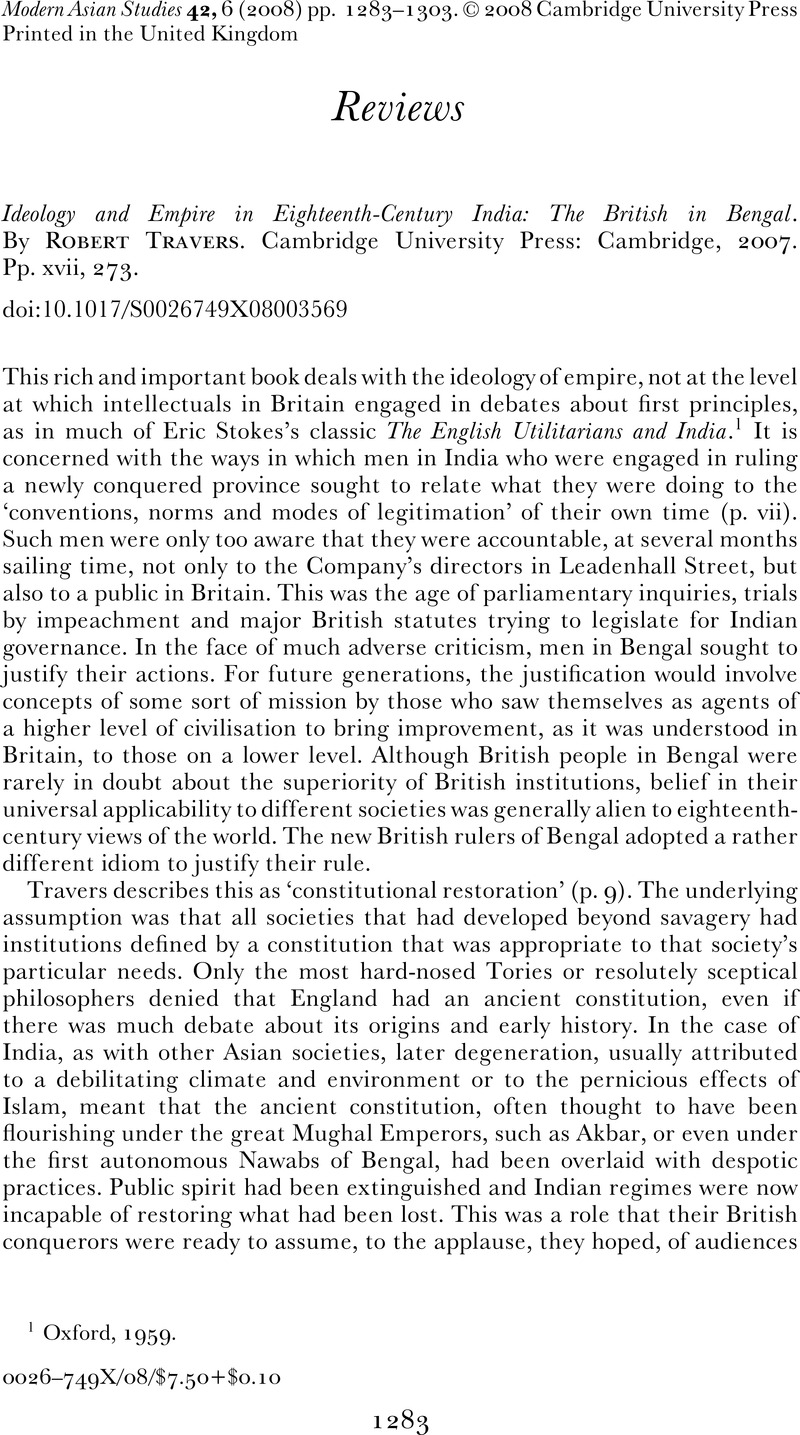Published online by Cambridge University Press: 01 November 2008

1 Oxford, 1959.
2 Marshall, P. J., ‘Britain and the world in the eighteenth century: III, Britain and India’, Transactions of the Royal Historical Society, 6th ser., X (2000), p. 9Google Scholar.
3 Khan, A.M., The Transition in Bengal, 1756–1775: A Study of Saiyid Muahmmad Reza Khan (Cambridge, 1969), p. 13.CrossRefGoogle Scholar
4 Letter of F. Sykes, 8 Nov. 1773, Weitzman, S., Warren Hastings and Philip Francis (Manchester, 1929), p. 208Google Scholar.
5 Paris, 1963.
6 ‘Governing Property, Making Law: Land, Local Society and Colonial Discourse in Agrarian Bengal, c. 1785–c. 1830’, Oxford D. Phil. thesis (2000). For a concise statement of Dr Wilson's arguments, from which the above quotations are taken, see his ‘Anxieties of Distance: Codification in Early Colonial Bengal’, Modern Intellectual History, IV (2007), 7–23.
7 24 Geo. III, c. 25 sec. XXXIX.
8 Speech at Opening of Impeachment, 16 Feb. 1788, Marshall, P.J. (ed.), The Writings and Speeches of Edmund Burke, VI, India: The Launching of the Impeachment 1786–1788 (Oxford, 1991), p. 364.Google Scholar
9 Wilson, K., ‘Introduction: histories, empires, modernities’ in Wilson (ed.), A New Imperial History: Culture, Identity and Modernity in Britain and the Empire 1660–1840 (Cambridge, 2004), p. 13.Google Scholar
10 Sutherland, East India Company, p. 147; see also pp. 219–222.
11 Ibid., p. 296.
12 Ibid., pp. 367–368.
13 For an appeal made in 1986 for historians of Hanoverian Britain to recognise ‘the fundamental social, economic, political, legal and constitutional problems raised with the advance of British rule’ in India, see Lawson, Philip, ‘The Missing Link: The Imperial Dimension in Understanding Hanoverian Britain’, reprinted in Lawson, A Taste for Empire and Glory: Studies in British Overseas Expansion, 1660–1800 (Aldershot, 1997), no. IGoogle Scholar.
14 Cambridge, 1991, p. 101.
15 See above, p. 000. For North’ s comments, see Marshall, P.J., The Making and Unmaking of Empires: Britain, India and America c. 1750–1783 (Oxford, 2000), p. 202.Google Scholar
16 Notably in Wealth of Nations, Bk. IV, Ch. vii, pt. 3.
17 Thoughts on Our Acquisitions in the East-Indies, Particularly Respecting Bengal (London, 1772).
18 Asma Ahmad, The British Enlightenment and Ideas of Empire in India, 1756–1773 (University of London Ph.D. Thesis 2005).
19 A Rule of Property for Bengal.
20 Metcalf, T.R., Ideologies of the Raj (Cambridge, 1994), p. 17Google Scholar.
21 Bayly, C.A., Imperial Meridian: The British Empire and the World 1780–1830 (Harlow, 1989), p. 120Google Scholar.
22 To Althorp, 31 March 1781, Cannon, G. (ed.), The Letters of Sir William Jones, 2 vols. (Oxford, 1970), II. 463.Google Scholar
23 To Ashburton, 27 April 1783, ibid., II. 616.
24 Spencer, A. (ed.), The Memoirs of William Hickey, 4 vols. (London, 1912–1925), II. 182.Google Scholar
25 The political ambitions of the European community are discussed in my ‘The Whites of British India, 1780–1830: A Failed Colonial Society?’ reprinted in Marshall, Trade and Conquest: Studies in the Rise of British Dominance in India (Aldershot, 1993), no. XV.
26 Sen, N., ‘Warren Hastings and British sovereign authority in Bengal, 1774–80’, Journal of Imperial and Commonwealth History, XXV (1997), 59–81CrossRefGoogle Scholar.
27 The exchange of letters between Lord Rockingham, the new prime minister, and the Irish Patriot Lord Charlemont in April 1782 is a vivid illustration of this (Historical Manuscripts Commission: Charlemont MSS, 2 vols. (London, 1891–1894), I. 54–56).
28 Mackintosh, R. (ed.), Memoirs of Sir James Mackintosh, 2 vols. (London, 1835), I. 212.Google Scholar
29 Bayly, C.A., ‘Rammohan Roy and the Advent of Constitutional Liberalism in India, 1800–30’, Modern Intellectual History, IV (2007), 25–41CrossRefGoogle Scholar.
30 ‘Returning the British to South Asian History: The Limits of Colonial Hegemony’, in Bayly, The Origins of Nationality in South Asia: Patriotism and Ethical Government in the Making of Modern India (Delhi, 1998), p. 287.
31 Examined in Marshall, Making and Unmaking of Empires: Britain, India, pp. 154–155.
32 The Khan was the subject of fine study by A.M. Khan, The Transition in Bengal, to which Travers pays proper tribute.
33 Empire and Information: Intelligence Gathering and Social Communication in India, 1780–1870 (Cambridge, 1996), p. 88.
34 ‘Weaving Knowledge: Sir William Jones and Indian Pandits’ in G. Cannon and K.R. Brine (eds.), Objects of Enquiry: The Life, Contributions, and Influences of Sir William Jones (1746–1794) (New York, 1995), pp. 51–79; ‘The Career of Rādhākāntā Tarkavāgīśa, An Eighteenth-century Pandit in British Employ’, Journal of the American Oriental Society, CIX (1989), 627–633.
35 Rocher, ‘Career’, 633.
36 Ogborn, M., Indian Ink: Script and Print in the Making of the English East India Company (Chicago, 2007), p. 243CrossRefGoogle Scholar.
37 Hindu Kinship and Polity in Precolonial India (Cambridge, 2003), p. 3.
38 Ray, R.K., ‘Colonial Penetration and the Initial Resistance of the Mughal Ruling Class, the English East India Company and the Struggle for Bengal 1756–1800’, Indian Historical Review, XII (1985), 1–105Google Scholar.
39 See my ‘The Muharram Riot of 1779 and the Struggle for Status and Authority in Early Colonial Calcutta’, Journal of the Asiatic Society of Bangladesh (Humanities), L (2005), 293–314.
40 Bushnell, A.T. and Greene, J.P., ‘Peripheries, Centers, and the Construction of Early Modern American Empires: An Introduction’ in Daniels, C. and Kennedy, M.V. (eds.), Centers and Peripheries in the Americas, 1500–1820 (New York, 2002), p. 6.Google Scholar
41 Journal of Asian Studies, XXIX (1970), 799–806.
42 Bengal: The British Bridgehead. Eastern India 1740–1828 (Cambridge, 1987), p. 100.
43 Olson, A.G., Making the Empire Work; London and American Interest Groups 1690–1790 (Cambridge, MA, 1992).Google Scholar
44 ‘A Thousand Countries to go to: Peasants and Rulers in Late Eighteenth-century Bengal’, Past and Present, CLXXXIX (2005), 92.
45 See also Khan, Transition in Bengal, pp. 1–16 and the discussion of regional Indian ‘patriotisms’ in C.A Bayly, ‘The Consolidation of Indian Patrias and the Colonial Encounter’ in Origins of Nationality, Ch. 2.
46 Hindu Kingship, p. 3.